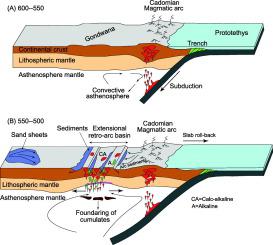Our official English website, www.x-mol.net, welcomes your
feedback! (Note: you will need to create a separate account there.)
Cadomian magmatic rocks from zarand (SE Iran) formed in a Retro-Arc Basin
Lithos ( IF 2.9 ) Pub Date : 2020-08-01 , DOI: 10.1016/j.lithos.2020.105569 Fatemeh Sepidbar , Hadi Shafaii Moghadam , Congying Li , Robert J. Stern , Peng Jiantang , Yusef Vesali
Lithos ( IF 2.9 ) Pub Date : 2020-08-01 , DOI: 10.1016/j.lithos.2020.105569 Fatemeh Sepidbar , Hadi Shafaii Moghadam , Congying Li , Robert J. Stern , Peng Jiantang , Yusef Vesali

|
Abstract A major arc-related magmatic episode is recorded in the Ediacaran-Early Cambrian (Cadomian) crust of Iran and Anatolia due to the southward subduction of Prototethyan oceanic lithosphere beneath N Gondwana. This magmatism was generated at a convergent margin, fragments of which can be traced for thousands of kilometres, from west Avalonia to the Lhasa terrane. Cadomian crustal tracts in Iran and Tauride-Anatolia are represented by abundant arc-like plutonic and volcanic rocks and a series of retro-arc, rifted basins dominated by thick sequences of terrigenous rocks as well as both calc-alkaline and alkaline magmatic rocks. This paper presents new zircon U-Pb as well as geochemical-isotopic data from plutonic (granite to gabbro) and volcanic (basalt to rhyolite) magmatic rocks of a Cadomian retro-arc rifted basin from Zarand in SE Iran. Geochemical data indicate two different geochemical signatures; high K calc-alkaline-shoshonitic, characterized by strong depletions in Nb, Ta, P, Ti, and alkaline rocks (and A1-type intrusions), with strong OIB-like trace element patterns. Cadomian OIB-like rocks- as well as A1-type intrusions- are rare in the basements of Iran and Anatolia and are only documented as minor gabbroic intrusions and/or (meta-) volcanic rocks from Saghand (central Iran), NE Iran and from exotic blocks from Ediacaran salt domes. Moreover, A2-type granites are also present in the Cadomian crust of Iran. Zarand volcanic rocks are interlayered with Rizu-Dezu terrigenous sedimentary rocks, whereas plutonic rocks intruded these metasediments. New zircon U-Pb ages show that high K calc-alkaline-shoshonitic rocks formed ~ 537-536 Ma, whereas A1-type granites crystallized at ~535 Ma. Most zircons from A1-type granites show positive eHf(t) values from +1.1 to +5.1, mostly higher than high K calc-alkaline-shoshonitic rocks with eHf (t) between −6.6 and +8.1. Bulk rock Nd-Sr isotopic data (e.g., ɛNd(t)= +0.3 to +4.0) for OIB-like rocks confirm that these rocks originated from an enriched OIB-like mantle source, whereas high K calc-alkaline-shoshonitic rocks (with eNd(t) = −7.7 to −6.2) show strong interaction with, and/or re-melting of a continental crust. Our results are consistent with an interpretation that the Zarand volcanic-plutonic rocks as well as associated thick sequences of sedimentary strata rocks formed in a retro-arc rifted basin behind the Cadomian magmatic arc. This basin seems to have developed during the Ediacaran at ~570-560 Ma with deposition of Ediacaran Morad to Lower Cambrian Rizu-Dezo sedimentary rocks. The retro-arc extensional basin seems to have become magmatically active at 540-535 Ma, as shown by the occurrence of both high K calc-alkaline- shoshonitic and OIB-like magmatic rocks. This basin was flanked by a cratonic hinterland towards Gondwana and a magmatic arc to the N. The cratonic hinterland fed detritus with detrital zircons older than 0.6 Ga into the basin, whereas the magmatic arc shed detritus with 500-600 Ma old zircons. Our compiled and new data from Ediacaran-Early Paleozoic magmatic rocks also show that Cadomian high magmatic fluxes occurred differently in parts of Iran-Anatolia, with overlaps in some areas.
中文翻译:

来自扎兰德(伊朗东南部)的 Cadomian 岩浆岩形成于逆弧盆地
摘要 由于北冈瓦纳大陆之下的原提斯大洋岩石圈向南俯冲,在伊朗和安纳托利亚的埃迪卡拉纪-早寒武纪(Cadomian)地壳中记录了一次与弧相关的主要岩浆事件。这种岩浆作用产生于会聚边缘,其碎片可以追溯到数千公里,从西阿瓦隆尼亚到拉萨地体。伊朗和陶里德-安纳托利亚的 Cadomian 地壳带以丰富的弧状深成岩和火山岩和一系列以陆源厚层序以及钙碱性和碱性岩浆岩为主的弧后裂谷盆地为代表。本文介绍了来自伊朗东南部 Zarand 的 Cadomian 逆弧裂谷盆地的深成岩(花岗岩到辉长岩)和火山岩(玄武岩到流纹岩)岩浆岩的新锆石 U-Pb 以及地球化学同位素数据。地球化学数据表明两种不同的地球化学特征;高钾钙碱性钾长石,其特征是 Nb、Ta、P、Ti 和碱性岩石(和 A1 型侵入体)的强烈枯竭,具有强烈的 OIB 类微量元素模式。Cadomian OIB 类岩石以及 A1 型侵入体在伊朗和安纳托利亚的地下室中很少见,仅记录为来自萨甘德(伊朗中部)、伊朗东北部和/或(变质)火山岩的小型辉长岩侵入体和/或(变)火山岩。来自埃迪卡拉纪盐丘的异国情调方块。此外,A2型花岗岩也存在于伊朗的Cadomian地壳中。扎兰德火山岩与日祖-德祖陆源沉积岩夹层,而深成岩侵入这些变质沉积物。新的锆石 U-Pb 年龄表明高 K 钙碱性钾长石岩形成~537-536 Ma,而 A1 型花岗岩在~535 Ma 结晶。大多数来自 A1 型花岗岩的锆石显示出 +1.1 至 +5.1 的正 eHf(t) 值,主要高于 eHf (t) 在 -6.6 至 +8.1 之间的高 K 钙碱性钾长石岩。OIB 类岩石的大块岩石 Nd-Sr 同位素数据(例如,ɛNd(t)=+0.3 至 +4.0)证实这些岩石起源于富集的 OIB 类地幔源,而高 K 钙碱性钾长石质岩石( eNd(t) = -7.7 到 -6.2) 显示出与大陆地壳的强烈相互作用和/或重新熔化。我们的结果与在 Cadomian 岩浆弧后面的弧后裂谷盆地中形成的 Zarand 火山-深成岩以及相关厚层沉积岩层序的解释一致。这个盆地似乎是在埃迪卡拉纪时期在约 570-560 Ma 形成的,埃迪卡拉纪莫拉德沉积到下寒武统 Rizu-Dezo 沉积岩。弧后伸展盆地似乎在 540-535 Ma 变得岩浆活动,如高 K 钙碱性钾长玄武岩和 OIB 类岩浆岩的出现所示。该盆地的两侧是朝向冈瓦纳的克拉通腹地和朝向北面的岩浆弧。克拉通腹地将含有 0.6 Ga 以上的碎屑锆石的碎屑送入盆地,而岩浆弧则将碎屑与 500-600 Ma 的碎屑一起送入盆地。我们从埃迪卡拉纪-早古生代岩浆岩收集的新数据还表明,伊朗-安纳托利亚部分地区的卡多米高岩浆通量不同,在某些地区重叠。弧后伸展盆地似乎在 540-535 Ma 变得岩浆活动,如高 K 钙碱性钾长玄武岩和 OIB 类岩浆岩的出现所示。该盆地的两侧是朝向冈瓦纳的克拉通腹地和朝向北面的岩浆弧。克拉通腹地将含有 0.6 Ga 以上的碎屑锆石的碎屑送入盆地,而岩浆弧则将碎屑与 500-600 Ma 的碎屑一起送入盆地。我们从埃迪卡拉纪-早古生代岩浆岩收集的新数据还表明,伊朗-安纳托利亚部分地区的卡多米高岩浆通量不同,在某些地区重叠。弧后伸展盆地似乎在 540-535 Ma 变得岩浆活动,如高 K 钙碱性钾长玄武岩和 OIB 类岩浆岩的出现所示。该盆地的两侧是朝向冈瓦纳的克拉通腹地和朝向北面的岩浆弧。克拉通腹地将含有 0.6 Ga 以上的碎屑锆石的碎屑送入盆地,而岩浆弧则将碎屑与 500-600 Ma 的碎屑一起送入盆地。我们从埃迪卡拉纪-早古生代岩浆岩收集的新数据还表明,伊朗-安纳托利亚部分地区的卡多米高岩浆通量不同,在某些地区重叠。该盆地的两侧是朝向冈瓦纳的克拉通腹地和朝向北面的岩浆弧。克拉通腹地将含有 0.6 Ga 以上的碎屑锆石的碎屑送入盆地,而岩浆弧则将碎屑与 500-600 Ma 的碎屑一起送入盆地。我们从埃迪卡拉纪-早古生代岩浆岩收集的新数据还表明,伊朗-安纳托利亚部分地区的卡多米高岩浆通量不同,在某些地区重叠。该盆地的两侧是朝向冈瓦纳的克拉通腹地和朝向北面的岩浆弧。克拉通腹地将含有 0.6 Ga 以上的碎屑锆石的碎屑送入盆地,而岩浆弧则将碎屑与 500-600 Ma 的碎屑一起送入盆地。我们从埃迪卡拉纪-早古生代岩浆岩收集的新数据还表明,伊朗-安纳托利亚部分地区的卡多米高岩浆通量不同,在某些地区重叠。
更新日期:2020-08-01
中文翻译:

来自扎兰德(伊朗东南部)的 Cadomian 岩浆岩形成于逆弧盆地
摘要 由于北冈瓦纳大陆之下的原提斯大洋岩石圈向南俯冲,在伊朗和安纳托利亚的埃迪卡拉纪-早寒武纪(Cadomian)地壳中记录了一次与弧相关的主要岩浆事件。这种岩浆作用产生于会聚边缘,其碎片可以追溯到数千公里,从西阿瓦隆尼亚到拉萨地体。伊朗和陶里德-安纳托利亚的 Cadomian 地壳带以丰富的弧状深成岩和火山岩和一系列以陆源厚层序以及钙碱性和碱性岩浆岩为主的弧后裂谷盆地为代表。本文介绍了来自伊朗东南部 Zarand 的 Cadomian 逆弧裂谷盆地的深成岩(花岗岩到辉长岩)和火山岩(玄武岩到流纹岩)岩浆岩的新锆石 U-Pb 以及地球化学同位素数据。地球化学数据表明两种不同的地球化学特征;高钾钙碱性钾长石,其特征是 Nb、Ta、P、Ti 和碱性岩石(和 A1 型侵入体)的强烈枯竭,具有强烈的 OIB 类微量元素模式。Cadomian OIB 类岩石以及 A1 型侵入体在伊朗和安纳托利亚的地下室中很少见,仅记录为来自萨甘德(伊朗中部)、伊朗东北部和/或(变质)火山岩的小型辉长岩侵入体和/或(变)火山岩。来自埃迪卡拉纪盐丘的异国情调方块。此外,A2型花岗岩也存在于伊朗的Cadomian地壳中。扎兰德火山岩与日祖-德祖陆源沉积岩夹层,而深成岩侵入这些变质沉积物。新的锆石 U-Pb 年龄表明高 K 钙碱性钾长石岩形成~537-536 Ma,而 A1 型花岗岩在~535 Ma 结晶。大多数来自 A1 型花岗岩的锆石显示出 +1.1 至 +5.1 的正 eHf(t) 值,主要高于 eHf (t) 在 -6.6 至 +8.1 之间的高 K 钙碱性钾长石岩。OIB 类岩石的大块岩石 Nd-Sr 同位素数据(例如,ɛNd(t)=+0.3 至 +4.0)证实这些岩石起源于富集的 OIB 类地幔源,而高 K 钙碱性钾长石质岩石( eNd(t) = -7.7 到 -6.2) 显示出与大陆地壳的强烈相互作用和/或重新熔化。我们的结果与在 Cadomian 岩浆弧后面的弧后裂谷盆地中形成的 Zarand 火山-深成岩以及相关厚层沉积岩层序的解释一致。这个盆地似乎是在埃迪卡拉纪时期在约 570-560 Ma 形成的,埃迪卡拉纪莫拉德沉积到下寒武统 Rizu-Dezo 沉积岩。弧后伸展盆地似乎在 540-535 Ma 变得岩浆活动,如高 K 钙碱性钾长玄武岩和 OIB 类岩浆岩的出现所示。该盆地的两侧是朝向冈瓦纳的克拉通腹地和朝向北面的岩浆弧。克拉通腹地将含有 0.6 Ga 以上的碎屑锆石的碎屑送入盆地,而岩浆弧则将碎屑与 500-600 Ma 的碎屑一起送入盆地。我们从埃迪卡拉纪-早古生代岩浆岩收集的新数据还表明,伊朗-安纳托利亚部分地区的卡多米高岩浆通量不同,在某些地区重叠。弧后伸展盆地似乎在 540-535 Ma 变得岩浆活动,如高 K 钙碱性钾长玄武岩和 OIB 类岩浆岩的出现所示。该盆地的两侧是朝向冈瓦纳的克拉通腹地和朝向北面的岩浆弧。克拉通腹地将含有 0.6 Ga 以上的碎屑锆石的碎屑送入盆地,而岩浆弧则将碎屑与 500-600 Ma 的碎屑一起送入盆地。我们从埃迪卡拉纪-早古生代岩浆岩收集的新数据还表明,伊朗-安纳托利亚部分地区的卡多米高岩浆通量不同,在某些地区重叠。弧后伸展盆地似乎在 540-535 Ma 变得岩浆活动,如高 K 钙碱性钾长玄武岩和 OIB 类岩浆岩的出现所示。该盆地的两侧是朝向冈瓦纳的克拉通腹地和朝向北面的岩浆弧。克拉通腹地将含有 0.6 Ga 以上的碎屑锆石的碎屑送入盆地,而岩浆弧则将碎屑与 500-600 Ma 的碎屑一起送入盆地。我们从埃迪卡拉纪-早古生代岩浆岩收集的新数据还表明,伊朗-安纳托利亚部分地区的卡多米高岩浆通量不同,在某些地区重叠。该盆地的两侧是朝向冈瓦纳的克拉通腹地和朝向北面的岩浆弧。克拉通腹地将含有 0.6 Ga 以上的碎屑锆石的碎屑送入盆地,而岩浆弧则将碎屑与 500-600 Ma 的碎屑一起送入盆地。我们从埃迪卡拉纪-早古生代岩浆岩收集的新数据还表明,伊朗-安纳托利亚部分地区的卡多米高岩浆通量不同,在某些地区重叠。该盆地的两侧是朝向冈瓦纳的克拉通腹地和朝向北面的岩浆弧。克拉通腹地将含有 0.6 Ga 以上的碎屑锆石的碎屑送入盆地,而岩浆弧则将碎屑与 500-600 Ma 的碎屑一起送入盆地。我们从埃迪卡拉纪-早古生代岩浆岩收集的新数据还表明,伊朗-安纳托利亚部分地区的卡多米高岩浆通量不同,在某些地区重叠。











































 京公网安备 11010802027423号
京公网安备 11010802027423号